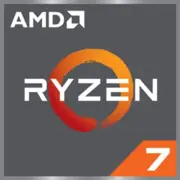AMD Ryzen 7 5800X3D

AMD Ryzen 7 5800X3D: A Comprehensive Review of the Processor for Gamers and Enthusiasts
Current as of April 2025
Key Characteristics: Zen 3 Architecture and Revolutionary Cache
The AMD Ryzen 7 5800X3D became a flagship product in 2022, and even in 2025, it remains relevant due to its unique engineering solutions.
Architecture and Process Technology
- Cores and Threads: 8 cores, 16 threads based on Zen 3 microarchitecture.
- Process Technology: 7nm TSMC FinFET technology provides a balance between performance and energy efficiency.
- Cache Memory: The main feature is 96 MB of L3 cache (three times larger than the standard Ryzen 7 5800X) thanks to 3D V-Cache technology. This stacked memory is placed above the die, reducing latency in games and resource-intensive applications.
- Clock Speeds: Base clock of 3.4 GHz, maximum clock of 4.5 GHz.
Performance
- Geekbench 6: 2085 points (single-core), 10922 (multi-core). For comparison, the Ryzen 7 7700X scores around ~2300/12500, but in games, the 5800X3D often outperforms it due to the cache.
- Gaming: In AAA titles (e.g., Cyberpunk 2077, Microsoft Flight Simulator), FPS gains can reach 15-25% compared to standard Zen 3 processors.
Compatible Motherboards: AM4 Socket and Selection Nuances
The processor uses the AM4 socket, allowing upgrades to older systems without replacing the motherboard.
Supported Chipsets
1. X570 and B550: Optimal choice. They support PCIe 4.0, which is important for modern graphics cards and NVMe drives.
- Examples: ASUS ROG Strix X570-E ($250), MSI B550 Tomahawk ($180).
2. A520 and X470/B450: Work after a BIOS update, but PCIe 4.0 is unavailable. Suitable for budget builds.
Important!
- To enable all features (e.g., SAM — Smart Access Memory), the latest BIOS version is required.
- Some entry-level boards (A520) may limit RAM frequency.
Memory: DDR4 and Optimization
The Ryzen 7 5800X3D supports only DDR4 (DDR5 is incompatible with AM4).
RAM Recommendations
- Frequency: Optimal range is 3200–3600 MHz. Higher frequencies (up to 4000 MHz) are possible, but the performance boost is minimal.
- Timings: Kits with low latencies (CL14–CL16) are preferred. For example, G.Skill Trident Z Neo 3600 MHz CL16 ($120 for 32 GB).
- Mode: Ensure the use of a dual-channel configuration.
Power Supply: Power Calculation
With a TDP of 105 W, the processor is not overly power-hungry, but it's important to have headroom for peak loads and other components.
Recommendations
- Minimum: 650 W (for systems with GPUs like RTX 4070 or RX 7800 XT).
- Ideal: 750–850 W (for high-end GPUs such as RTX 4090).
- Certification: 80+ Gold or higher. Examples: Corsair RM750x ($130), Seasonic Focus GX-850 ($150).
Tip: Don't skimp on the PSU! Cheap models may destabilize under peak loads.
Pros and Cons: Who is the 5800X3D For?
Advantages
1. Best Gaming Processor for AM4: Outperforms many new releases in 2024-2025 in gaming.
2. Energy Efficiency: 105 W compared to 170 W of Intel Core i9-12900K.
3. Compatibility: Suitable for motherboards from 2017 to 2022.
Disadvantages
1. No support for DDR5 and PCIe 5.0.
2. No overclocking potential: Frequencies are locked due to the peculiarities of 3D V-Cache.
3. Price: In 2025 — $300-350, which is more expensive than the Ryzen 5 7600X ($250).
Usage Scenarios: Gaming, Rendering, Streaming
Gaming
The processor is ideal for 1440p and 4K gaming. In CS2 or Valorant, FPS exceeds 400+, while in demanding scenes of Starfield, it consistently maintains 60–90 FPS.
Work Tasks
- Rendering: In Blender or Maya, it falls short compared to the Ryzen 9 7900X, but due to the cache, it performs faster than the 5800X.
- Streaming: 16 threads are sufficient for gaming and video encoding in OBS simultaneously.
Multimedia
Fast photo processing in Lightroom, 4K video editing in Premiere Pro (but for professional work, 12-core CPUs are better).
Comparison with Competitors
Intel Core i7-12700K ($320 in 2025)
- Pros: Better in multi-threaded tasks (20 threads), supports DDR5.
- Cons: Higher power consumption (190 W), performs 5-10% weaker in gaming.
Ryzen 7 7700X ($340)
- Pros: New AM5, DDR5, PCIe 5.0.
- Cons: In gaming, the 5800X3D often wins, especially in "CPU-dependent" projects.
Verdict: The 5800X3D is the choice for gamers, while competitors are better for work tasks.
Practical Assembly Tips
1. Cooling: Even with a TDP of 105 W, the processor heats up under load. Choose tower coolers (like the Noctua NH-D15 ($100)) or AIOs (like the NZXT Kraken X63 ($150)).
2. Case: Ensure good ventilation. Minimum of 2 intake fans and 1 exhaust fan.
3. Memory: 32 GB (2×16 GB) DDR4-3600 is optimal.
4. BIOS: Update the BIOS to the latest version before installing the CPU.
Final Conclusion: Who Should Choose the Ryzen 7 5800X3D?
This processor is worth considering if:
- You are a gamer looking to maximize FPS on AM4 without moving to DDR5.
- You already have an AM4 PC and want an upgrade without motherboard replacement.
- You value energy efficiency and stability.
Do not purchase the 5800X3D if:
- You are building a system from scratch and plan to use DDR5/PCIe 5.0.
- You need a processor for rendering or 3D modeling.
Price/Performance: In 2025, the 5800X3D remains a great option for gamers, especially in the used market (new — $300-350). Its unique architecture with 3D V-Cache proves that sometimes "old" can be better than new.
Basic
CPU Specifications
Memory Specifications
GPU Specifications
Miscellaneous
Benchmarks
Compared to Other CPU
Related CPU Comparisons
Share in social media
Or Link To Us
<a href="https://cputronic.com/index.php/cpu/amd-ryzen-7-5800x3d" target="_blank">AMD Ryzen 7 5800X3D</a>
